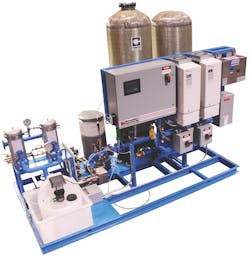Save It For a Rainy Day
Global freshwater demand tripled over the second half of the 20th century as the world population more than doubled and technological advances allowed users access to groundwater from greater depths than ever before. As global demand soars, pressures on the world’s water resources are straining aquatic systems worldwide. Rivers are running dry, lakes are disappearing and water tables are dropping.
Population growth and economic development are driving forces behind a steadily increasing demand for new water supplies. The Earth’s water is comprised of 97.5% saltwater. The impact of this statement resonates louder with the following example: If the world’s water supply could fit into a bucket, only one teaspoonful would be drinkable.
In the next century, demand for water harvesting pumping systems will increase as municipalities, homeowners, business owners and commercial and industrial building owners realize the benefits of capturing, storing, filtering and using harvested rainwater for such purposes as flushing plumbing fixtures, irrigating parks and fields, washing laundry and vehicles, and as mechanical makeup feedwater for industrial processes.
Benefits of water harvesting pump systems abound. They reduce water bills and alleviate demand on municipal systems. More importantly, they reduce demand on our limited potable water supplies. Metropolitan Industries Inc., Romeoville, Ill., is a designer and manufacturer of these systems for the commercial, municipal and industrial markets.
A recent project involved working with engineer Mark Nykowski of HP Critical Facilities Services, Chicago. The endeavor - Project Dolphin - involved the harvesting of rainwater, which is intended to be used as a pressurized source of water for flushing plumbing fixtures and as an emergency source of water for the facility’s critical cooling tower makeup demand.
Project Dolphin
During periods of rain, rainwater falls on the so-called harvest zone. In the case of Project Dolphin, the harvest zone is the rooftop of the facility. The rainwater is collected via the roof-drain system, and eventually it flows into four underground reservoirs. Each of the reservoirs has a gross storage capacity of 40,000 gal, for a total gross storage capacity of 160,000 gal.
The underground storage reservoirs are installed using an interconnecting piping arrangement. It allows the reservoirs to store equal amounts of water and lets all of the water flow toward a Metropolitan factory-prefabricated underground rainwater pressurization station.
The pressurization station is designed to collect the gravity flow from the underground reservoirs and direct the flow of the water through two aspiration units that will reduce the particulate matter in the water down to 20 microns before being pumped. The station includes two variable-speed submersible pumps, each designed to pressurize the rainwater at a peak flow rate of 80 gal per minute (gpm), with a target output pressure of 80 psi and with a combined peak flow of 160 gpm.
The station is designed to allow the aspiration units and pumps to be removed for maintenance, inspection and repair from grade elevation without the need to drain the reservoirs or station. It also prevents the need for personnel to enter the confined space of the station’s wet well.
One feature that sets the system design apart from that of other rainwater harvesting systems is an integral dry-well chamber, adjacent to the wet well. This chamber is designed to encase the discharge piping of the station, as well as the isolation valves, silent check valves and pressure monitoring gear. This chamber is much shallower than the wet well, and it is designed to allow personnel to enter.
Once the pressurized rainwater exits the pressurization station, the water travels below grade and enters a mechanical room that houses a Metropolitan factory prefabricated rainwater treatment station.
The rainwater treatment station is a complex fabrication that must allow for aeration of the water in the underground storage reservoirs. It controls and operates the pumps in the underground pressurization station and performs critical functions to ensure the safe reuse of the harvested rainwater. The treatment station will filter, disinfect, recirculate and colorize the water.
The treatment station includes a programmable logic control center, pressure transducers, flowmeter and variable-frequency drives that operate in unison to control the flow and pressure of the water from the pressurization station. Once the rainwater enters the treatment station, the flow path first takes the water through a pair of redundant cartridge filters, which further reduce the particulate matter down to 5 microns before allowing the water to flow into the system’s ultraviolet (UV) disinfection unit. This filtration is critical to the effectiveness of the UV treatment, as larger particle sizes may tend to allow “shadowing” of other particles, rendering the UV treatment less effective.
Upon exiting the UV chamber, a precisely measured portion of the water flow is allowed to flow through a recirculation port, which is routed to an aeration device in a predetermined point in the arrangement of underground storage reservoirs. This measured flow is critical in ensuring that the stored water does not become anaerobic.
Next, the water is injected with a metered quantity of calcium hypochlorite, which not only provides additional disinfection beyond the UV treatment but also allows residual disinfection of the water for extended periods of time.
Finally, prior to leaving the treatment system on the way to the intended service, the filtered, disinfected water is injected with blue food-grade dye. The dye is added to provide instant identification of secondary water in order to ensure that any cross-connection with freshwater supplies within the facility is avoided.
Download: Here
